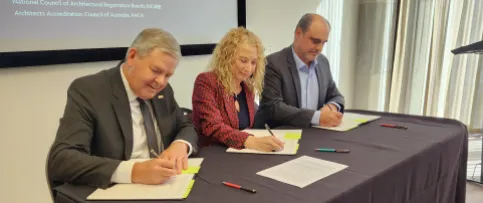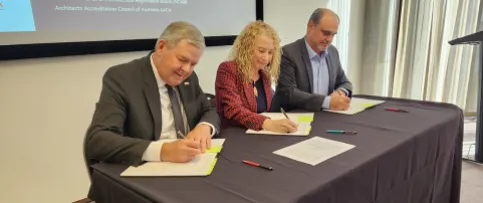Washington, DC—Canada’s Regulatory Organizations of Architecture in Canada (ROAC), Mexico’s Comité Mexicano para la Práctica Internacional de la Arquitectura (COMPIAR), and the United States’ National Council of Architectural Registration Boards (NCARB) launched an updated Tri-National Mutual Recognition Agreement (MRA) on October 1, increasing access to international practice opportunities for architects in North America.
The updated agreement recognizes the level of competency established through each country’s initial licensure/registration processes and removes several post-licensure barriers to eligibility. Through these changes, ROAC, COMPIAR, and NCARB maintain the level rigor needed to protect the public while ensuring that all qualified architects who are interested in pursuing international licensure/registration now have a pathway to reciprocity.
“The amendment to the Mutual Recognition Agreement (MRA), preserves the principles of transparency and responsibility, expanding equal opportunities to professionally practice architecture among the countries of the Mexico, United States and Canada Treaty (T-MEC). It includes more accessible requirements that will increase its potential coverage, while reducing the economic burden,” said Mtra. Victoria Rodríguez Mosqueda, President of the Federación de Colegios de Arquitectos de la Republica Mexicana (FCARM).
The revised agreement also includes several operational updates to streamline the application process, removing administrative burdens and allowing architects to earn reciprocity more efficiently.
"We are pleased about this updated agreement, which removes barriers and improves mobility for licensed architects to perform their work in our three countries. Well-regulated professions, like architecture, are crucial for thriving societies and economies. While easing the path for architects to practise in other jurisdictions, we are maintaining important safeguards to ensure the protection of the public interest, including a safe, healthy built environment,” said Ian Ross McDonald, Architect AIBC, LEED GA, who chairs the ROAC Board of Directors.
New Eligibility Criteria
The updated Tri-National Mutual Recognition Agreement between ROAC, COMPIAR, and NCARB addressed common barriers for interested architects, including:
- Reducing the required number of years of post-licensure experience from 10 to five, expanding eligibility to architects who have been licensed/registered more recently. In addition, the updated agreement reduces restrictions around where that experience can take place.
- Accepting architects who obtained their license/registration through various routes, including alternative qualifications pathways. This expands access to international reciprocity to a wider pool of architects.
- Removing the citizenship requirement, allowing architects who are not citizens of their home country to seek reciprocal licensure/registration.
By addressing these barriers, ROAC, COMPIAR, and NCARB are enabling more qualified architects to take advantage of an increasingly global marketplace, while maintaining the essential level of rigor needed to protect the public.
“The updated agreement marks an exciting new stage in our relationship with Canada and Mexico founded on mutual respect and recognition. Now our NCARB Certificate holders who achieved licensure via non-traditional paths will be able to access this MRA, and do it in a more cost-effective and efficient manner. We look forward to supporting architects from all three countries as they take advantage of this opportunity to practice at the international level.” said NCARB President Kenneth R. Van Tine, AIA, NCARB, LEED AP.
Establishing the Agreement
The Tri-National Mutual Recognition Agreement between Canada, Mexico, and the United States was first signed in 2005, representing over 10 years of negotiations according to the North American Free Trade Agreement (NAFTA), now USMCA. It was later approved in 2007 by representatives of the governments of the three countries before the NAFTA Commission. The original agreement was subsequently amended in 2010.
The 2024 updates are the result of additional research and negotiation, with an underlying goal of removing barriers and providing qualified architects with the opportunity to offer professional services across borders while ensuring the protection of the health, safety, and welfare of the public.
The agreement is based on an assessment of similarities in architecture licensing/registration standards as established by NCARB for utilization by its member jurisdictions and the requirements for registration in Canada and Mexico.
To learn more about earning a license/registration to practice architecture abroad, including specific eligibility requirements, visit www.ncarb.org/international.
Read this press release in Spanish.
About NCARB
The National Council of Architectural Registration Boards’ membership is made up of the architectural licensing boards of the 50 states, the District of Columbia, Guam, the Northern Mariana Islands, Puerto Rico, and the U.S. Virgin Islands. NCARB, in collaboration with these boards, facilitates the licensure and credentialing of architects to protect the health, safety, and welfare of the public.
To achieve these goals, NCARB works with its Member Boards and volunteers to develop and facilitate standards for licensure, including the national examination and experience program. NCARB also recommends regulatory guidelines for licensing boards and helps architects expand their professional reach through the NCARB Certificate. Connect with NCARB on Twitter, Instagram, Facebook, and YouTube.
About ROAC
(ROAC) represents the eleven provincial and territorial regulators of the profession of architecture in Canada. These regulatory bodies are responsible for setting the standards for entry into the profession and for issuing registration/licenses to those who meet established standards of qualifications and practice. These regulators individually regulate the practice of architecture so that the public interest is protected within their respective province or territory.
Through ROAC, the Canadian architectural regulators work collectively to develop and adopt nationally recognized standards and programs which meet their regulatory responsibilities as well as the needs of the architectural profession.
About COMPIAR
The Mexican Committee for the International Practice of Architecture (COMPIAR) was established by the Mexican government as the agency responsible for reciprocal negotiations for mutual recognition agreements with relevant bodies of Canada and U.S., and other countries, regarding practice of foreign architects in México and Mexican architects abroad. It is composed by representatives of the professional and academic organizations in México under a joint presidency, the Federación de Colegios de Arquitectos de la República Mexicana A.C. (FCARM) and the Asociación de Instituciones de la Enseñanza de la Arquitectura de la Republica Mexicana A.C. (ASINEA), includes as institutional advisors, representatives of the Acreditadora Nacional de Programas de Arquitectura y del Espacio Habitable A.C. (ANPADEH) as the accrediting body of architectural programs in México, and the Consejo Nacional de Registro de la Certificación Profesional (CONARC) which certifies the professional practice of architects according to the international agreements signed by the COMPIAR representatives. It also includes representatives of government agencies; the Dirección General de Profesiones of the Secretaria de Educación Pública, the Dirección General de Comercio de Servicios e Inversión General of the Secretaria de Ecónomia and the Instituto Nacional de Migración of the Secretaria de Gobernación. COMPIAR has an Executive Coordinator for its management.





